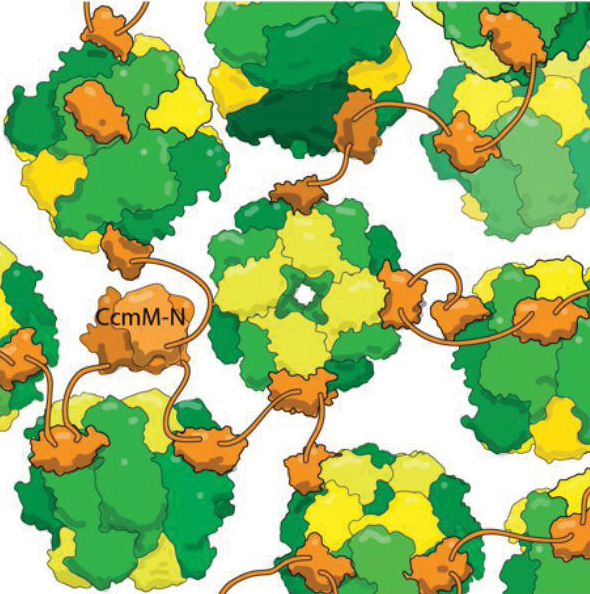JBC: How bacteria build efficient photosynthesis machines
Researchers facing a future world with a larger human population and more uncertain climate are looking to photosynthetic bacteria for engineering solutions to improve crop yields.
In the Journal of Biological Chemistry, a Canadian research team on how cyanobacteria finesse one of the most wasteful steps in photosynthesis. The study investigated the assembly of carboxysomes in which the bacteria concentrate carbon dioxide, boosting the efficiency of a critical enzyme called RuBisCO.
“Essentially everything we eat starts with RuBisCO,” said , a professor at the University of Guelph in Ontario and senior author on the paper.
The enzyme, which is made of 16 protein subunits, is essential for photosynthesis. Using energy captured from light, it incorporates carbon dioxide into organic molecules from which a plant then builds new sugar. Unfortunately, it’s not terribly efficient. Or, from Kimber’s point of view, “RuBisCO has a really thankless task.”
The enzyme evolved in an ancient world where carbon dioxide was common and oxygen was rare. As a result, it isn’t very picky in discriminating between the two gases. Now that the atmospheric tables have turned, RuBisCO often accidentally captures oxygen, generating a useless compound that the plant then has to recycle.

Cyanobacteria make few such mistakes, because bacteria collect their RuBisCO into dense bodies known as carboxysomes. The bacteria pump bicarbonate (simply hydrated CO2) into the cell; once it gets into the carboxysome, enzymes convert the bicarbonate into carbon dioxide. Because the carbon dioxide can’t escape through the protein shell surrounding the carboxysome, it builds up to high concentrations, helping RuBisCO avoid costly mistakes.
Kimber wants to understand the logic of carboxysomes’ organization. “They’re actually phenomenally intricate machines,” he said. “The cyanobacterium makes 11 or so normal-looking proteins, and these somehow organize themselves into this self-regulating mega-complex that can exceed the size of a small cell.”
One of carboxysomes’ most impressive tricks is self-assembly, which Kimber’s lab set out to understand. They looked at a protein, CcmM, that corrals RuBisCO enzymes into new carboxysomes. They knew that part of CcmM looks a lot like a subunit of RuBisCO — so much so that researchers suspect ancient cyanobacteria created CcmM by duplicating a RuBisCO gene.
Most scientists in the field believed that CcmM binds to the enzyme by usurping that RuBisCO subunit’s spot. But when Kimber’s lab took a detailed look at CcmM’s structure and binding, the results showed that was wrong. True, CcmM was similar in shape to the small RuBisCO subunit. But the complexes it formed still included all eight small subunits, meaning that instead of stealing a spot from a RuBisCO subunit, CcmM had to be binding elsewhere.
“This is very odd from a biological perspective, because if CcmM arose by duplicating the small subunit, it almost certainly originally bound in the same way,” Kimber said. “At some point, it must have evolved to prefer a new binding site.”
The researchers also found that a linker between binding domains in CcmM is short enough that “instead of wrapping around RuBisCO, it tethers (individual enzymes) together like beads on a string,” Kimber said. “With several such linkers binding each RuBisCO at random, it crosslinks everything into this big glob; you wrap a shell around it, and this then becomes the carboxysome.”
last fall that they had succeeded in making tobacco plants with a stripped-down carboxysome in their chloroplasts. Those plants didn’t grow especially well, and the authors concluded that they had taken away too many components of the carboxysome; although it could be built in the chloroplast, it was a drag on the plants instead of a help.
A better understanding of how proteins like CcmM contribute to carboxysome construction and function could help bioengineers leverage carboxysome efficiency in the next generation of engineered plants.
Enjoy reading ASBMB Today?
Become a member to receive the print edition four times a year and the digital edition monthly.
Learn moreGet the latest from ASBMB Today
Enter your email address, and we鈥檒l send you a weekly email with recent articles, interviews and more.
Latest in Science
Science highlights or most popular articles

Understanding the roles of extracellular matrix and vesicles in valvular disease
MOSAIC scholar Cassandra Clift uses mass spectrometry and multiomics to study cardiovascular calcification and collagen dysregulation, bridging her background in bioengineering and biology to investigate extracellular vesicles and heart disease.

Lipid profiles reveal sex differences in type 2 diabetes
Researchers explored the lipid profiles of individuals with type 2 diabetes and identified potentially useful lipid biomarkers for this condition.

Serum lipids may predict early diabetes risk
Researchers found that levels of two key fatty acids may predict worsening tolerance for glucose, independent of body fat and insulin levels. In turn, these fatty acids may serve as early T2D biomarkers.

Sex and diet shape fat tissue lipid profiles in obesity
Researchers found that sex hormone levels and diet both influence inflammation and lipid composition in obesity.

Mapping the placenta鈥檚 hormone network
Study uncovers how the placenta actively metabolizes not only glucocorticoids but also novel androgens and progesterones, reshaping our understanding of pregnancy and its complications.

Biochemists and molecular biologists sweep major 2025 honors
Recent Nobel, MacArthur and Kimberly Prize honorees highlight the power of biochemistry and molecular biology to drive discovery, including immune tolerance, vaccine design and metabolic disease, and to advance medicine and improve human health.

